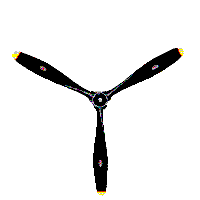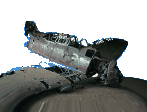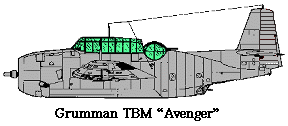Ft. Lauderdale, FL
NAS Ft. Lauderdale
In 1997, all that remains is the dilapidated Junior Bachelor Officers' quarters on the west side of Ft. Lauderdale-Hollywood International Airport. Even that is doomed (if not gone already). Broward county purchased it for unknown purposes. Famous residents of the quarters or of the base are a young George Bush and Flight 19.
George Bush
On active duty from August 1942 to September 1945, Mr. Bush flew torpedo bombers off the USS San Jacinto. On September 2, 1944, Mr. Bush's plane was hit by anti-aircraft fire while making a bombing run over the Bonin Island of Chichi Jima, 600 miles south of Japan. Although the plane was on fire and severely damaged, he completed his strafing run on the targeted Japanese installation before flying towards sea to bail out. Mr. Bush was able to bail out successfully and was rescued by a Navy submarine, the USS Finback. Tragically, his two crew members were killed. For his courageous service in the Pacific Theater, Mr. Bush was awarded the Distinguished Flying Cross and three Air Medals.
 Flight
19 "The Lost Patrol"
Flight
19 "The Lost Patrol"
It was on a beautiful, sunny Florida afternoon, December 5, 1945 when Flight 19 (five TBM Avengers) climbed into the sky above NAS Fort Lauderdale, FL. They turned east over the Atlantic on the first leg of a routine exercise and rendezvous with the unknown — a rendezvous from which the 14 men of Flight 19 would never return. The same fate met the 13-man crew of a PBM Mariner sent out to rescue them.
This mission was a routine two-hour patrol from Fort Lauderdale due east for 150 miles, north for 40 miles and then return to base. All five pilots were highly experienced aviators and all of the aircraft had been carefully checked prior to take-off. The leader was a combat veteran with 2509 hours, most of it in type. The TBMs had enough fuel to remain aloft for five to five-and-a-half hours. The weather over the route was reported to be excellent, a typical sunny Florida day. At 1545 (only one hour and 35 minutes after takeoff) Fort Lauderdale tower received a call from the flight but, instead of requesting landing instructions, the flight leader sounded confused and worried.
"Cannot see land," he blurts. "We seem to be off course."
"What is your position?" the tower asks.
There are a few moments of silence. No sign of the flight.
"We cannot be sure where we are," the flight leader announces. "Repeat: Cannot see land."
Contact was lost with the flight for about 10 minutes and then resumed.
But, it  was
not the voice of the flight leader. Instead, voices of the crews were
heard, sounding confused and disoriented, "more like a bunch of boy
scouts lost in the woods than experienced airmen flying in clear weather."
was
not the voice of the flight leader. Instead, voices of the crews were
heard, sounding confused and disoriented, "more like a bunch of boy
scouts lost in the woods than experienced airmen flying in clear weather."
"We can't find west. Everything is wrong. We can't be sure of any direction. Everything looks strange, even the ocean."
Another delay and then the tower operator learned to his surprise that the leader had handed over his command to another pilot for no apparent reason. Twenty minutes later, the new leader called the tower, his voice trembling and bordering on hysteria.
"We can't tell where we are . . . everything is . . . can't make out anything. We think we may be about 225 miles northeast of base . . ."
For a few moments the pilot rambled incoherently before uttering the last words ever heard from Flight 19:
"It looks like we are entering white water . . . We're completely lost."
Within minutes a Mariner flying boat, carrying rescue equipment, was on its way to Flight 19's last estimated position. Ten minutes after takeoff, the PBM checked in with the tower and then . . . was never heard from again. Coast Guard and Navy ships and aircraft combed the area for the six aircraft. They found a calm sea, clear skies, moderate winds up to 40 miles per hour and nothing else. For five days almost 250,000 square miles of the Atlantic Ocean and Gulf were searched. Yet, not a flare was seen, not an oil slick, life raft or tel-tale piece of wreckage is ever found.
Finally, after an extensive Navy Board of Inquiry investigation is completed, the riddle remains intact. The Board's report is summed up in one terse statement: "We are not able to even make a good guess as to what happened."
These disappearances sparked one of the largest air and sea searches
in history as hundreds of ships and aircraft combed more than 200,000
square miles of the Atlantic Ocean and Gulf of Mexico. On land search
parties combed the interior of Florida on the chance that the aircraft
might have crashed undetected. Nothing was ever found — no wreckage,
no bodies ... nothing. All that remains is the mystery. A mystery that
became: Flight 19 "The Lost Patrol." It is now the central mystery
of the legend of the "Bermuda Triangle." Much has been written
and speculated about the Triangle, a stretch of ocean credited by some as being "the graveyard of the Atlantic,"
home of the forbidding Saragasso Sea. The "Triangle" is an area
whose boundaries stretch roughly from Miami to the Bermuda Islands, southward
to Puerto Rico and west to the Florida Keys. Reports as far back as 1840
assert that men, ships and aircraft have disappeared with alarming regularity.
Why? It depends on whom you talk to. Some claim that this Voodoo Sea is
a maritime vortex, that supernatural forces are at work. Others assert
that strange magnetic and natural forces unique to the area and unknown
to modern science are responsible for the disappearances. Some even say
creatures from outer space claimed the victims. Still more believe that
with the heavy sea and high density traffic moving through the area, it
is inevitable that some unexplained "incidents" happen. But
no matter what the argument or rationale, there is something oddly intriguing
about these occurrences, particularly the "normal" circumstance
that is always reported prior to each incident.
of ocean credited by some as being "the graveyard of the Atlantic,"
home of the forbidding Saragasso Sea. The "Triangle" is an area
whose boundaries stretch roughly from Miami to the Bermuda Islands, southward
to Puerto Rico and west to the Florida Keys. Reports as far back as 1840
assert that men, ships and aircraft have disappeared with alarming regularity.
Why? It depends on whom you talk to. Some claim that this Voodoo Sea is
a maritime vortex, that supernatural forces are at work. Others assert
that strange magnetic and natural forces unique to the area and unknown
to modern science are responsible for the disappearances. Some even say
creatures from outer space claimed the victims. Still more believe that
with the heavy sea and high density traffic moving through the area, it
is inevitable that some unexplained "incidents" happen. But
no matter what the argument or rationale, there is something oddly intriguing
about these occurrences, particularly the "normal" circumstance
that is always reported prior to each incident.
See the Search Section, "Question from France"for information about markings